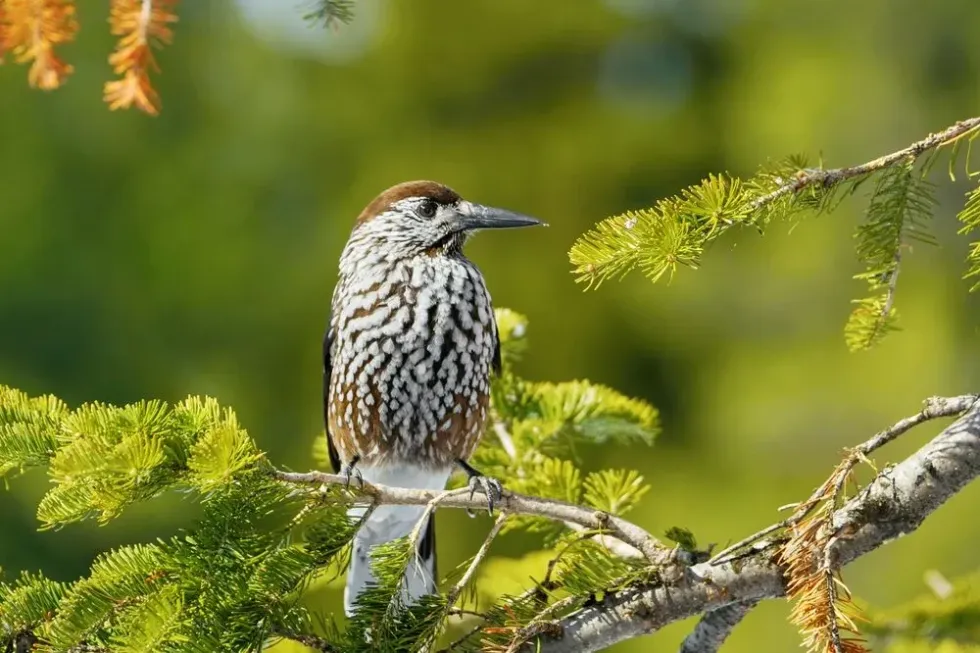The nutcracker is a genus of bird with three different species. These birds fall into the family Corvidae, which makes them relatives of the crows and the jays. The three species of nutcracker birds are the Clark’s nutcracker, the spotted nutcracker, and the large spotted nutcracker.
These birds species live in mountains filled with coniferous trees, mainly pines, where they can get their primary diet of pine seeds or pine nuts. They may eat spruce seeds found in the forest as well. They generally don’t migrate. The exception to this is when their food supply is affected.
The nutcracker bird species are very intelligent. In winter, and up to 9 months later, the bird remember where they buried these seeds!
The Clark’s nutcracker is found in the mountain ranges of western North America. The Spotted nutcracker is found across several mountain ranges from Scandinavia to Japan. The Large Spotted nutcracker bird is found in the western Himalayas.
You may also check out the fact files on lark sparrow and ani bird from Kidadl.
Nutcracker Interesting Facts
What type of animal is a nutcracker?
Nutcrackers of the genus Nucifraga are birds.
What class of animal does a nutcracker belong to?
As a kind of bird, the nutcrackers are of the class Aves, just like ani birds and lovebirds.
How many nutcrackers are there in the world?
As these birds are not under any threat, their numbers are not closely monitored. But the spotted nutcracker is estimated to have a large population, with 800,000-1,700,000 individuals in Europe alone.
Where does a nutcracker live?
Mountain ranges in the northern hemisphere with coniferous forests, especially pines.
What is a nutcracker's habitat?
Nutcracker birds live primarily in coniferous forests where they have access to their primary source of food: pine seeds. They bury excess seeds in summer and go back for them in the winter.
The range of land they occupy is very large. The rarely come down to altitudes where people live. But they might depending on their access to food. Shortage of pine seeds is the only reason for the birds to consider migration. They do not migrate according to climate or at all. They only move if food supply is affected.
Who do nutcrackers live with?
Nutcrackers may be found in flocks in their habitat, and they don’t have a habit of migration. Typically they stick to their family units. This comprises of the adults and young birds.
How long does a nutcracker live?
There is very little information about the lifespan of the nutcracker genus. Among nutcrackers, there are records of Clark’s nutcrackers living up to 17 years.
How do they reproduce?
Nutcrackers reproduce like all birds. A mating pair will build a nest together, and then lay eggs. Both birds settle in to look after the eggs during the nesting period in early spring. Nutcracker eggs hatch 18 days later and the young remain with their families till they’re fully grown.
What is their conservation status?
There are no apparent threats to the species in the nutcracker genus at the time. Climate change may eventually affect this genus. For now all these species, the Clark’s nutcracker, the spotted nutcracker and the large spotted nutcracker, have been classified as Least Concern.
Nutcracker Fun Facts
What do nutcrackers look like?
All species of the nutcracker bird genus are evolved to extract pine seeds or pine nuts from pine cones. The nutcracker bird beaks, also known as bills, are long, sharp and specialized extracting the pine seeds from the pine cones in the summer, and store them for the winter in caches.
The Clark’s nutcracker has ashy-gray feathers with a distinct black and white tail and wings. Its beak, legs and feet are black. It is slightly smaller than its cousin the spotted nutcracker.
The spotted nutcracker has feathers that range from light to dark chocolate brown. It has a throat pouch that allows it to store seeds. The Clark’s nutcracker can store up to 150 seeds in its pouch.
The large spotted nutcracker has a blackish head and neck. It wings and tail are black with white tips.

How cute are they?
The nutcracker birds are not cute. They are medium sized and strongly resemble little crows. The young birds aren’t particularly cute either. But if you think crows or jays are cute, then you will probably think that the nutcracker birds are cute too!
How do they communicate?
Nutcrackers have loud and harsh calls which are their primary vocalizations to their family and their young to warn for danger. They also have softer calls that we don’t have a lot of information about.
Nutcracker birds also have a type of song, that they likely sing during the breeding season. Baby nutcracker birds have a high-pitched sound they use to call their parents for food.
How big is a nutcracker?
Nutcracker birds have bodies that are an average of 12.5 in (31 cm). The Clark’s nutcracker is described as being the same size as jays. In contrast, their close cousin, the American crow, is anything between 16–20 in. This means that the nutcrackers are 1.5 times smaller than the average American crow.
How fast can a nutcracker fly?
There haven’t been many observations about the speed of the nutcracker birds. However, some people have observed the Clark’s nutcracker flying at speeds of 29.8 mph (47.9 kph).
How much does a nutcracker weigh?
Nutcracker birds weigh between 4.9–6.7 oz (138.9-189.9 g) similar to dollar bird.
What are the male and female names of the species?
There are no separate names for male or female birds in the nutcracker genus. They are simply called male and female nutcrackers.
What would you call a baby nutcracker?
There are no specific names for baby nutcracker birds. They may be referred to as juveniles or chicks, like the babies of their cousins, the crows.
What do they eat?
The nutcracker's diet mainly consists of eating pine seeds or pine nuts that they extract from pine cones. This is why they live in coniferous forests, and do not migrate. They may also eat the seeds of the spruce tree, and hazelnuts if necessary.
Are they friendly?
These birds mostly stick to themselves. They live in the mountains, in altitudes that are higher than human populations occupy with pines. So it is hard to say if they are friendly or not.
Would they make a good pet?
All three species of the nutcracker birds are wild animals. They belong in the forests and trees where they play an important role in the environment. They need the space and the food from the pine trees in their habitat and will not make good pets.
Did you know...
There are quite a few fun nutcracker facts. For instance, the spotted nutcracker has a specialized tongue, the tip is forked, like a snake’s tongue.
But the tips have surfaces that are hard like nails, to help them pull out the large seed from pine cones. The Clark’s nutcracker is helping to restore the whitebark pines by being the main disperser of the whitebark pine seeds.
The seed in its caches that it doesn’t eat in the winter germinate and propagate the species of pine.
Types of nutcracker
There are three species of birds under the nutcracker genus: the Clark’s nutcracker is found in North America: the spotted nutcracker is found in Europe and parts of east Asia: the large spotted nutcracker is found in the Himalayas.
How smart is a nutcracker bird?
Nutcracker birds are actually quite smart. They have an incredible memory of the locations of their seed and nut caches and store them for the winter. This is because the part of their brains that is responsible for memory, the hippocampus, is very large.
Here at Kidadl, we have carefully created lots of interesting family-friendly animal facts for everyone to discover! For more relatable content, check out these eared dove facts and night heron facts for kids.
You can even occupy yourself at home by coloring in one of our Nutcracker (Bird) coloring pages.










